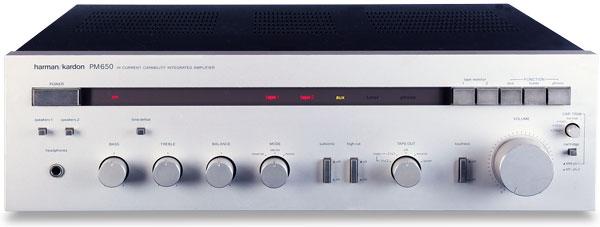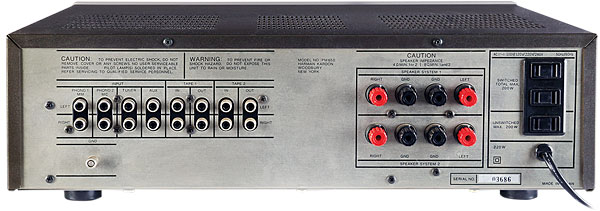Harman Kardon PM650

 The sweet spot in a three-strong series of late '80s amps, this high current integrated promised to handle low impedance speakers without breaking a sweat. We listen...
The sweet spot in a three-strong series of late '80s amps, this high current integrated promised to handle low impedance speakers without breaking a sweat. We listen...
Most hi-fi enthusiasts know how many watts their amplifier can produce, but does that figure tell the whole story? In the early '80s, Harman Kardon's HCC (High Current Capability) range of integrated amplifiers gave listeners another number to think about, which was how much current an amplifier was able to source.
The PM650 of 1982 reviewed here was one of a three-part series of integrated amps produced in Japan. Rated at 50W per channel, the amp offered greater power and more facilities than the basic 35W PM640 model in the lineup, while for those wanting a little extra, the range-topping PM660 offered 80W per channel and a few more knobs and buttons to fiddle with.
Carry That Load
The purpose of the high current output capability of the PM650 is difficult to fathom at first. Schoolboy mathematics suggest that the peak current drawn by an 8ohm load at 50W will be 3.5A, so why go to the trouble of supplying more? The answer lies in the true nature of loudspeakers, which do not present a load that is equivalent to a perfect 8ohm resistor. The impedance profile of a typical speaker can vary widely over the audio frequency range, from perhaps only a couple of ohms up to many tens. The more exaggerated these deviations are from the loudspeaker's nominal impedance the more taxing it is for the amplifier to drive.

Amps like the PM650 were designed to be as close as possible to an ideal voltage source, eg, the output voltage is an exact multiple of the input voltage regardless of the current that is drawn by the loudspeakers. This can clearly only be the case if sufficient current is available to satisfy this condition, hence the generous allowances made in the PM650 circuit.
What would the effect of running out of current be? In a moderate case, a non-uniformity of response would result, the amp being unable to provide enough drive at a particular frequency (eg, that corresponding to a low impedance point of the loudspeaker) and elsewhere in the spectrum. In extreme cases distortion, operation of protection circuits or the failure of the amp's output devices might occur, though this is rare in practice.

Heavy Metal
The design of a high current amplifier isn't greatly different to that of a conventional one at first sight. The first requirement is that the output impedance must be low, but that is not the complete story. The tiny amplifiers found in the servo systems of CD players also have a very low output impedance by virtue of the negative feedback loops that surround them. But in practice this is a theoretical position only as they cannot supply any real power into the sensitive loads they drive.
As well as a low output impedance generated by negative feedback, a high current amplifier also requires a high current power supply, output devices that are sturdy and minimum circuit resistance between the output devices and speaker terminals. All these factors were engineered into the PM650, which had a large mains transformer and dual rectifier/reservoir sets – one per channel. This latter approach was something of an HK trademark at the time and was also seen in the 'twin powered' HK505 amplifier [HFN Oct '16]. To keep the output resistance low one finds thick PCB tracks, heavy wiring and big speaker binding posts inside the PM650, along with the absence of the usual speaker protection relay. In its place are two thermal cutouts, but these are slow acting and may not be fast enough to save your speakers if something goes awry.

Feature Packed
The modest speaker switches seem to be at odds with HK's high current principles, but tests undertaken at the time suggested that a remarkable ±39A (peak) might be obtained from the PM650. High current circuitry aside, the PM650 was a typical middleweight amplifier of the immediately pre-CD era. Three inputs and two tape loops with cross-dubbing options were provided, the turntable input being switchable between MM and MC cartridges. This facility was particularly well engineered, with separate input sockets for the two different types of cartridge and variable capacitance loading for the MM input. No fewer than 30 transistors were employed in the RIAA preamplifier alone, a far from penny-pinching specification for an integrated amplifier in its class.
Meanwhile, high and low cut filters, a loudness circuit and the ability to play in mono or with the two stereo channels reversed were also included in the design, although a well planned fascia meant that the PM650 was still an attractive product that was simple to operate.


















































